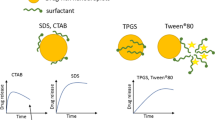Abstract
The objective of this study was to investigate the effects of sodium lauryl sulfate upon the saturation solubility of carbamazepine, its dissolution kinetics, and T50% defined as the time required for dissolving 50% of carbamazepine. Water, 0.1N-HCI, and phosphate buffers at pH 4.0 and 6.8 containing 0.1, 0.5, 1, and 2% sodium lauryl sulfate were used as dissolution media. The dissolution study was conducted by using the USP dissolution apparatus II with an agitation rate of 75 rpm. Samples of the dissolution media were taken in 7, 15, 30, 45, 60, 75, and 90 min, and the amounts of carbamazepine were determined spectrophotometrically at 285 nm. All dissolution data were fitted well into a four-parameter exponential equation:Q = a(1 — e-bxt)+c(1 — e-dxt). In this equation Q represented % carbamazepine dissolved at a time t, anda, b, c, andd were constants. This equation led to the calculation of dissolution rates at various time points and T50%. It was found that the dissolution rate of carbamazepine was directly proportional to the aqueous concentration of sodium lauryl sulfate. In addition, under our experimental conditions T50% values ranged from 37.8 to 4.9 min. It was interesting to note that T50% declined rapidly as the surfactant concentration increased from 0.1 to 0.5%, whereas it declined more slowly at concentrations greater than 1 %. These results clearly demonstrated that the dissolution rate of carbamazepine and duration of its dissolution test could be tailored by optimizing the amount of sodium lauryl sulfate in a dissolution medium.
Similar content being viewed by others
References
Abrahamsson, B., Johansson, D., Torstensson, A., and Wingstrand, K., Evaluation of solubilizers in the drug release testing of hydrophilic matrix extended-release tablets of felodipine.Pharm. Res., 11, 1093–1097 (1994).
Aunins, J. G., Southard, M., Meyers, R. A., Hemmelstein, K. J., and Stella, V. J., Dissolution of carboxylic acids III. The effect of polyionizable buffers.J. Pharm. Sci., 74, 1305–1316 (1985).
Castillo, J. A., Palomo-Canales, J., Garcia, J. J., Lastres, J. L., Bolas, F., and Torrado, J. J., Preparation and characterization of albendazole β-cyclodextrin complexes.Drug Dev. Ind. Pharm., 25, 1241–1248 (1999).
Chen, L. R., Wesley, J. A., Bhattachar, S., Ruiz, B., Bahash, K., and Babu, S. R., Dissolution behavior of a poorly water soluble compound in the presence of Tween 80.Pharm. Res., 20, 797–801 (2003).
Costa, P., and Lobo, J. M. S., Influence of dissolution medium agitation on release profiles of sustained-release tablets.Drug Dev. Ind. Pharm., 27, 811 -817 (2001).
Crison, J. R., Weiner, N. D., and Amidon, G. L., Dissolution media for in vitro testing of water-insoluble drugs: effect of surfactant purity and electrolyte onin vitro dissolution of carbamazepine in aqueous solutions of sodium lauryl sulfate.J. Pharm. Sci., 86, 384–388 (1997).
Dawoodbhai, S.et al., Optimization of tablet formulation talc.Drug Dev. Ind. Pharm., 17, 1343–1371 (1991).
FDA, Center for Drug Evaluation and Research. Guidance for Industry - Extended release oral dosage forms: development, evaluation and application ofin vitro/in vivo correlation, September 1997b.
FDA, Center for Drug Evaluation and Research. Guidance for Industry - Immediate release solid dosage forms: Scale-up and postapproval changes (SUPAC-IR): Chemistry, manufacturing, and controls,in vitro dissolution testing andin vivo bioequivalence test documentation, November, 1995.
FDA, Center for Drug Evaluation and Research. Guidance for Industry - SUPAC-MR: Modified release solid oral dosage forms: Scale-up and postapproval changes: Chemistry, manufacturing, and controls;in vitro dissolution testing andin vivo bioequivalence documentation, September 1997a.
Jain, A. C. and Adeyeye, M. C., Hygroscopicity, phase solubility and dissolution of various substituted sulfobutylether β-cyclodextrins (SBE) and danazol-SBE inclusion complexes.Int. J. Pharm., 212, 177–186 (2001).
Kervinen, L. and Yliruusi, J., Modelling S-shaped dissolution curves.Int. J. Pharm., 92, 115–122 (1993).
Langernbucher, F., Linearization of dissolution rate curves by the Weibull distribution.J. Pharm. Pharmacol., 24, 979–981 (1972).
Pena Romero, A.et al., Water uptake and force development in an optimized prolonged release formulation.Int. J. Pharm., 73, 239–248 (1991).
Qazi, S., Peter Samuel, N. K., Venkatachalam, T. K., and Uckun, F. M., Evaluating dissolution profiles of an anti-HIV agent using ANOVA and non-linear regression models in JMP software.Int. J. Pharm., 252, 27–39 (2003).
Riegelman, S., and Collier, P., The application of statistical moment theory to the evaluation of the in vivo dissolution time and absorption time.J. Pharmacokient. Biopharm., 8, 509–534 (1980).
Serajuddin, A. T., and Rosoff, M., pH-solubility profile of papaverine hydrochloride and its relationship to the dissolution rate of sustained-release pellets.J. Pharm. Sci., 73, 1203–1208 (1984).
Shah, V. P., Konecny, J. J., Everett, R. L., McCullough, B., Noorizadeh, A. C., and Skelly, J. P.,In vitro dissolution profile of water-insoluble drug dosage forms in the presence of surfactants.Pharm. Res., 6, 612–618 (1989).
Sun, W., Larive, C. K., and Southard, M. Z., A mechanistic study of danazol dissolution in ionic surfactant solutions.J. Pharm. Sci., 92, 424–435 (2003).
Velasco-De-Paola, M. V. R., Santoro, M. I. R. M., and Gai, M. N., Dissolution kinetics evaluation of controlled-release tablets containing propranolol hydrochloride.Drug Dev. Ind. Pharm., 25, 535–541 (1999).
Author information
Authors and Affiliations
Rights and permissions
About this article
Cite this article
Lee, H., Park, SA. & Sah, H. Surfactant effects upon dissolution patterns of carbamazepine immediate release tablet. Arch Pharm Res 28, 120–126 (2005). https://doi.org/10.1007/BF02975147
Received:
Issue Date:
DOI: https://doi.org/10.1007/BF02975147




